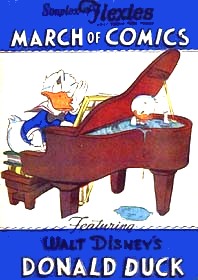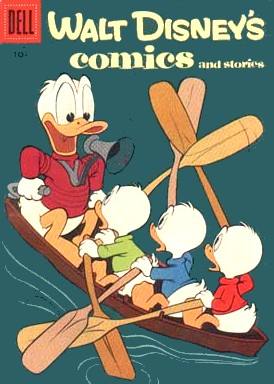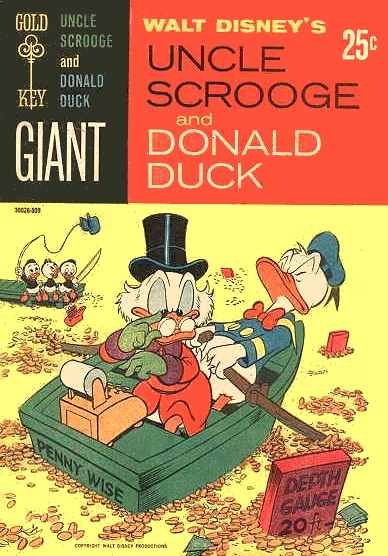

In 1942 Jack Hannah and Carl Barks worked
together to draw a comic book story called Donald
Duck finds Pirate's Gold. At the time they
were both worked at the Disney Studios. They used all their spare
time that summer to complete the venture. They showed the story
to Western Publishing who held the licence to produce the Disney
comics. Their work was accepted.
Barks decided to take a job offer from Western in 1943 when the
company decided to stop reproducing Sunday strips in their comic
books and instead publish new stories. He immediately received
the script for a Donald Duck ten-pager which he finished after
altering a few details to Western's great delight. 'The
Victory Garden' was the result.
The following years Barks worked as a duck artist at his home in San Jacinto and both parties found it a fine solution. It was very rare that an illustrator was allowed to work at home. On top of that it was quite unusual that he worked alone. Most of the other writers were given a synopsis and then different illustrators drew the story. Barks did it all alone. He continued happily at Western until he retired in 1966.
Here is a brief history of the Western Publishing Company, which employed Carl Barks for 25 years.
THE TIMELINE Walt
Disney started publishing his own comic stories in 1930
when he introduced a daily Mickey Mouse strip for the
newspapers. Some time later Western received a licence to
produce the Mickey Mouse Magazine. Disney wanted to earn
additional revenues from merchandise relating to his
animated films. The mastermind behind the overall idea
was Herman 'Kay' Kamen who was a marketing genius. He
licenced Mickey Mouse to a multitude of different sorts
of merchandise such as toothpaste, ice cream, clothing,
toys and cookies. In
1939 Kamen and Western editor Eleanor Packer started the
one-shot comic book series called Four Color which
contained a variety of Donald Duck newspaper strip
material. Kamen left Western shortly after. Four Color
became an instant success and in 1940 Packer gave the
ailing Mickey Mouse Magazine the more appealing name Walt
Disney's Comics and Stories. In the turbulent and successful years that followed, Western was the sole publisher of Disney comics although they were issued under a great variety of different names; K.K. Comics, Dell Comics, March of Comics, Red Ryder Comics, Gold Key Comics, Golden Publishing, Golden Press, Dynabrite, and Whitman Comics. After
28 years, Dell ended their agreement to distribute
Western's comics in 1962 and Gold Key Comics was created
instead. This marked the decline of Walt Disney's Comics
and Stories. They stopped publication in 1984. |
 March of Comics MOC41 - 1949 |
 Dell WDCS213 - 1958 |
 Gold Key FC0386 - 1965 (reprint) |
Whitman Daisy & Donald - 1978 |
THE EDITORS During Barks' employment between 1942 and 1966 at Western's Los Angeles branch he had several editors with whom he consulted when visiting the premises. Among the best known were: Eleanor
Lewis Packer Carl
von Buettner Craig
Chase |
Group photo from 1957 1: Craig Chase - 2: Carl Barks - 3: Carl Buettner |
THE EMPLOYEES Western had a multitude of comic book artists working for them and they used many of the cartoon characters of the time for their comic books. Here are some of the more famous artists for the Disney gallery. Barks,
Carl (1901-2000) Bradbury,
Jack (1914-2004) Buettner,
Carl (1903-1965) de
Lara, Phil (1914-1973) Eisenberg,
Harvey (1912-1965) Gottfredson,
Floyd (1906-1986) Hubbard,
Al (1914-1984) Kelly,
Walt (1913-1973) Murry,
Paul (1911-1989) Strobl,
Tony (1915-1991) Taliaferro,
Al (1905-1969) Turner, Gil
(1911 -1960) |
| http://www.cbarks.dk/THEPUBLISHER.htm | Date 2003-05-21 |